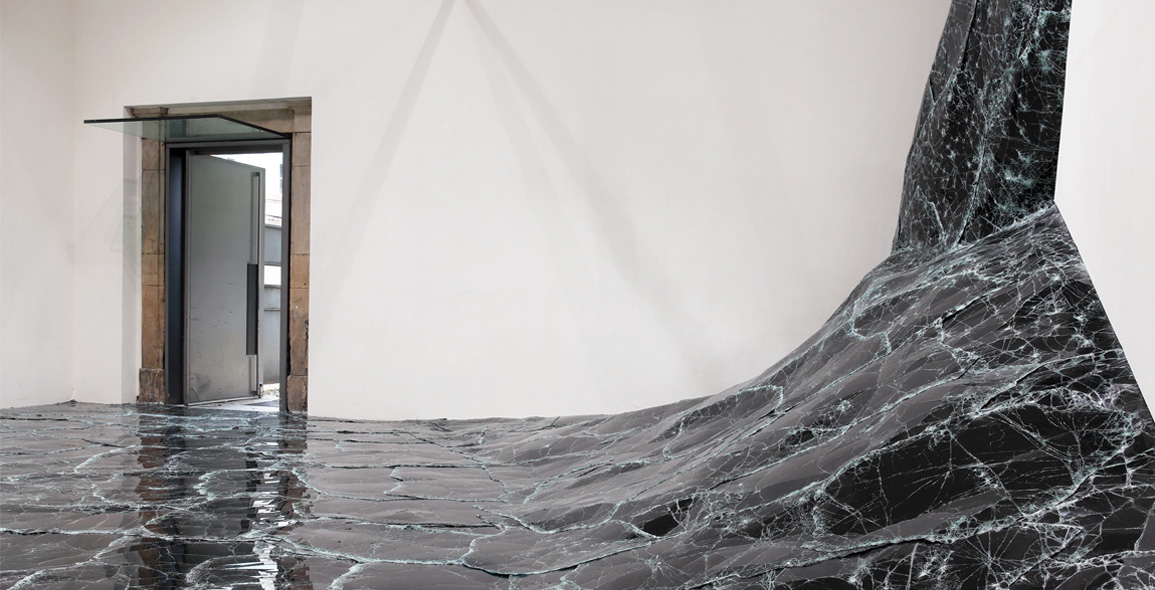
'Dark matter' is a phrase as suggestive as its nature is problematic. Once separated from the gravitational effect it seems to have on visible matter in the Universe (and it constitutes at least a quarter of said visible matter), ‘dark matter’ can only be the subject of hypothesis. Baptiste Debombourg injected the mysteries and necessities of this little-known cosmic element into his Chaufferie installation: an immersive mass of black glass, punctuated by a mask.
Dark layering flows over levels like a galactic sea in which cracks act as foam. The tangible treatment in monochrome black lends the work a status that is at least two-fold – sculptural and pictorial – and gives rise to additional questions related to the work’s setting, plane, vanishing points, surfaces, volume, reflections, and the position of the viewer, invited to walk on the uneven surface that creaks with each footstep. The audio dimension later appended to the work is one part of its phenomenological nature; it is a work designed to be experienced as much as seen. A ‘nigredo’ [alchemist’s initial phase], an experiment of the separation of substance as much as a symbolic ‘trial of the mind in discarding all forms of routine and prejudice.’ (The Abyss by Marguerite Yourcenar)

By walking through the installation, these surface appearances or ambiguous visions are revealed – generated by its mirrored aspect. The transformation of the space, induced by the white, almost totemic shape, of the wall – the remaining segment of the room’s original state – highlights the unreliable nature of reflections. The cracks condition the corners, which de-condition the body, whose position becomes critical. The mask, installed where the flow is interrupted, reproduces this vision indefinitely by diffracting the glass, and reflects a shifting image of appearance and disappearance for the viewer. ‘A reflection is a presence that has no place or does not occur.’
Rather than a ‘non-place’, the site is of an undefined nature and is revealed through the cadence of a stroll, a space-time with a specular aura. Beneath the glass glaze that wail when walked on, images sprout, in which sky and ground merge, in a ‘reversible world’. These are the remains and consequences of an event: extreme compression – from which diamond and coal are derived – or spatial evaporation. We hesitate between the expansion and reduction of this dark matter, a source of mysticism that its materialism may contravene.

One of the side effects of this blackness, profound in its density and engulfing power, is to be transported beyond or ‘outré’. ‘Outrenoir' means: beyond the blackness is a reflected light, transmuted by the black’, ‘black that, ceasing to be, becomes a transmitter of clarity, a secret light’, ‘a mental field other than black’. ‘Other’ or displaced, since this particular monochrome follows the course of the constellations, subterranean waters, mining fissures, and the high and low cosmic evasions peculiar to the sensation of a glissade. (essay by Audrey Teichmann, independent curator and critic based in Geneva)
Artist Statement
All my projects are somehow related to aspects of human relationships: our mistakes, our doubts and desires, as well as perceptions we each have of our own realities. My work explores the nature of our psychological relationships with objects, looking for the potential space between reality and the ideal model we aspire to achieve. Thus, I analyse and question the sense and meaning of actions we undertake (construction and destruction). I am interested in individual repeated attempts, which sometimes lead to failure. Driven by well-intended actions, utopian aspirations or blinded by his ego, the individual reveals his true nature. The impression of impotence generated by such situations and by the individuals themselves simply highlights the fragile and endearing nature of the human being. My research takes shape through different media, materials, and mountings such as wood, glass, staples, or drawings. My inspiration and influences come from everyday life and more specifically from day-to-day objects that condition our lives. My analysis/research is also focused on the use of these objects and the reactions (/behaviours) that they create, including the affective relationships we may have with them. I consider my artistic oeuvre as a conveyor of encounters, an opportunity to link sectors and areas that usually ignore each other (ex: the so-called ‘noble’ and ‘popular’ cultures). I believe it is also a way to examine the position and the function of what we define as contemporary art. (Born in 1978, Baptiste Debombourg works and lives in Paris)

A print version of this article was originally published in d+a issue 89.


 Share
Share








